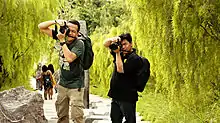Career consolidation
Career consolidation is a stage of adult development which involves "expanding one's personal identity to assume a social identity within the world of work."[1] This stage was developed by George Vaillant in 1977 and added to Erikson's stages of psychosocial development, between intimacy vs. isolation and generativity vs. stagnation.[2][3] This stage covers the ages of 25 to 35.[4] Vaillant contrasts career consolidation with self-absorption.[5]

To transform a job or hobby into a career, Vaillant argues that four criteria are necessary: contentment, compensation, competence, and commitment.[1]
It has been demonstrated that in adult development, intimacy, career consolidation, and generativity are mastered in that particular order for both men and women.[6] This is explained since in order to love their work (career consolidation), adults first should love their spouses (intimacy).[5] In order to care for others (generativity), adults should first love their work (career consolidation).[5]
References
- George E. Vaillant (1 January 2002). Aging Well: Surprising Guideposts to a Happier Life from the Landmark Harvard Study of Adult Development. Hachette Digital, Inc. p. 35. ISBN 978-0-316-98936-7. Retrieved 22 June 2012.
- George E. Vaillant (1977). Adaptation to Life. Harvard University Press. ISBN 978-0-674-00414-6. Retrieved 22 June 2012.
- Medalie, J. H. (1984). "Male midlife development". The Journal of family practice. 19 (2): 211–217. PMID 6747563.
- Michael B. Arthur; Douglas T. Hall; Barbara S. Lawrence (25 August 1989). Handbook of Career Theory. Cambridge University Press. p. 66. ISBN 978-0-521-38944-0. Retrieved 22 June 2012.
- George E. Vaillant (1995). The Wisdom of the Ego. Harvard University Press. p. 142. ISBN 978-0-674-95373-4. Retrieved 22 June 2012.
- George E. Vaillant (1995). The Wisdom of the Ego. Harvard University Press. p. 170. ISBN 978-0-674-95373-4. Retrieved 22 June 2012.